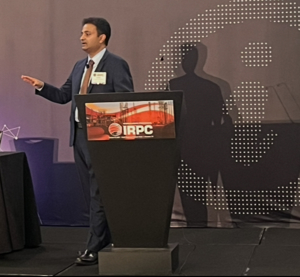IRPC Rewind: Advancement in large-scale pyrolysis technology for chemical recycling of plastics
At the International Refining and Petrochemical Conference (IRPC), Sudipto Chakraborty, Technology Manager for Advanced Plastic Pyrolysis Technology at Lummus Technology, presented groundbreaking advancements in scaling pyrolysis for chemical recycling of plastics. His talk, “Advancement in Large Scale Pyrolysis Technology”, outlined a path toward commercializing pyrolysis as a critical component of the circular plastics economy.
Chakraborty highlighted the pressing need for technologies capable of addressing post-consumer plastic waste, much of which is currently landfilled, mismanaged, or incinerated. Lummus envisions pyrolysis as a scalable solution that can transform mixed plastic streams—primarily polyethylene (HDPE, LDPE) and polypropylene—into high-value chemical feedstocks. While minor fractions of polystyrene, PET, PVC and other plastics are unavoidable, the process has been engineered to manage their impact effectively.
Reactor and process innovations. A key breakthrough in the Lummus design is the separation of plastic melting and pyrolysis reaction into distinct sections. This innovation overcame heat transfer challenges that have long hindered scale-up.
Chakraborty revealed that the latest commercial design employs a four-zone reactor with independently controlled temperatures. This allows optimized cracking, higher yields at lower temperatures, and—critically—continuous removal of pitch from the reactor bottom. By preventing buildup, the system enables 50+ days of continuous operation, a milestone for the industry.
Capacity has also been multiplied:
- A melt tank doubled throughput
- Redesigned reactor internals boosted capacity five-fold.
Together, these enhancements increased processing ability ten times over the original batch setup, enabling one reactor to handle 70 tpd.
The Lummus system produces a spectrum of products:
- Light pyrolysis oil (cracker-compatible, paraffinic and hydrogen-rich)
- Pyrolysis gas (up to 35% C3–C5 olefins, recoverable as olefinic LPG or usable for power)
- Pitch (4%–5% of feed, flowable and pumpable, serving as a sink for heavy metals and silica).
An additional heavy oil thermal cracking (HOTC) stage converts heavy fractions into lighter oils, while optional isoconversion units can further upgrade medium-range oils, maximizing cracker-ready outputs.
Contaminant management breakthroughs. One of the toughest challenges in chemical recycling is contamination from fillers, metals, and PVC-derived chlorides. Lummus has devised a multi-layered solution:
- Melt tank pretreatment removes ~50% of chlorides before the reactor
- Onsite alkaline addition reduces remaining chlorides to ~50 ppm
- Continuous pitch removal extracts silica and metals, protecting oil quality.
In collaboration with Chevron, Lummus has also filed a patent for a novel non-catalytic purification process. This system removes 98% of chlorides and 92% of silica, reducing contaminants to levels as low as 2 ppm–3 ppm chloride. This positions pyrolysis oil for direct blending into steam crackers or mild hydrotreating—without costly retrofits to existing refinery infrastructure.
Toward commercial deployment. Chakraborty emphasized that these innovations represent not just incremental improvements, but the foundation of a commercially viable, large-scale pyrolysis platform. With trains designed for 100,000 tpy and robust tolerance for diverse, imperfect feedstocks, Lummus Technology is aiming to make advanced pyrolysis a cornerstone of the plastics circular economy.







Comments